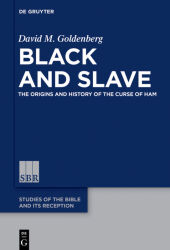 Neuerscheinungen 2017Stand: 2020-02-01 |
Schnellsuche
ISBN/Stichwort/Autor
|
Herderstraße 10
10625 Berlin
Tel.: 030 315 714 16
Fax 030 315 714 14
info@buchspektrum.de |

David M. Goldenberg
Black and Slave
The Origins and History of the Curse of Ham
2017. IX, 360 S. 6 b/w and 7 col. ill. 230 mm
Verlag/Jahr: DE GRUYTER 2017
ISBN: 3-11-052166-0 (3110521660)
Neue ISBN: 978-3-11-052166-5 (9783110521665)
Preis und Lieferzeit: Bitte klicken
The series Studies of the Bible and Its Reception (SBR) publishes monographs and collected volumes which explore the reception history of the Bible in a wide variety of academic and cultural contexts. Closely linked to the multi-volume project Encyclopedia of the Bible and Its Reception (EBR), this book series is a publication platform for works which cover the broad field of reception history of the Bible in various religious traditions, historical periods, and cultural fields. Volumes in this series aim to present the material of reception processes or to develop methodological discussions in more detail, enabling authors and readers to more deeply engage and understand the dynamics of biblical reception in a wide variety of academic fields.
Further information on " ".
Studies of the Curse of Ham, the belief that the Bible consigned blacks to everlasting servitude, confuse and conflate two separate origins stories (etiologies), one of black skin and the other of black slavery. This work unravels the etiologies and shows how the Curse, an etiology of black slavery, evolved from an earlier etiology explaining the existence of dark-skinned people. We see when, where, why, and how an original mythic tale of black origins morphed into a story of the origins of black slavery, and how, in turn, the second then supplanted the first as an explanation for black skin. In the process we see how formulations of the Curse changed over time, depending on the historical and social contexts, reflecting and refashioning the way blackness and blacks were perceived. In particular, two significant developments are uncovered. First, a curse of slavery, originally said to affect various dark-skinned peoples, was eventually applied most commonly to black Africans. Second, blackness, originally incidental to the curse, in time became part of the curse itself. Dark skin now became an intentional marker of servitude, the visible sign of the blacks´ degradation, and in the process deprecating black skin itself.
David M. Goldenberg, University of Pennsylvania, Philadelphia, PA, U.S.A.


